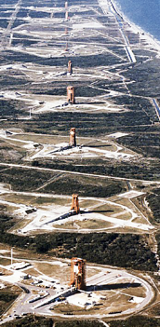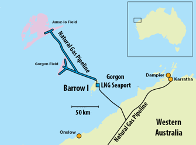MLS SPACEPORT DESIGN
A new spaceport design is needed to sustain an MLS launch rate of one rocket every five minutes — in effect, mass production of launched rockets. As a conceptual example, the spaceport would have two parallel ten-kilometer-long “launch lines,” separated by several kilometers. Each launch line would support 25 rocket launch pads and catch-towers (at 400 meters spacing).
Twenty-five rockets on a launch line would lift off in succession, one every five minutes for a period of two hours. Once a launch line has completed launching its rockets, the second launch line would begin, allowing two hours for the first launch line to be set up with 25 new rockets. Automated robots would manage launch operations, night and day, in all weather, year-round
Since the MLS Spaceport may launch as many as 288 rockets per day, fuel supply will be a major challenge. Six Raptor 2 rocket engines will produce about 87 million horsepower—or about 65,000 MW—during a 5-minute launch, including the second stage. [To put that into perspective, commercial nuclear power reactors typically generate about 1,000 MW.] For MLS rocket launches every 5 minutes, a continuous supply of cryogenic LNG (methane) would be needed. Ideally, both the large LNG plant and the co-located MLS Spaceport would be solar powered, obviating the need to burn methane to power operations.
In summary, candidate spaceport sites should have the following characteristics:
- near the equator to maximize payload to orbit;
- ocean or empty land several hundred km to east;
- remote from population centers, for safety and noise;
- co-located with large LNG plant to supply cryogenic methane;
- suitable for a large cryogenic liquid oxygen plant.
- ocean freighter port to import rockets, solar sail payloads, etc.
POSSIBLE WESTERN AUSTRALIA SPACEPORT SITE
Since long distance LNG pipelines are not possible (cryogenic temperatures cannot be maintained), MLS spaceport sites must co-located with large LNG plants. Locally produced liquid oxygen (LOX) is also a requirement. Parallel refueling of MLS rockets would require high volume pumping of liquid methane and liquid oxygen.
One potential MLS spaceport site is on Barrow Island, a 200 km2 island in the Indian Ocean, 50 km off the coast of Western Australia. The Gorgon LNG plant on Barrow Island can produce 15.6 million tonnes/year of LNG (plus a planned expansion of new wells in the Jansz-Io field). The MLS Spaceport requires about 17.5 million tonnes/year of LNG ~about the total output of the Gorgon LNG plant.
Except for a few personnel that run the Gorgon LNG plant , the island is uninhabited. To the east, downrange from the launch site, there is ocean and a vast area of almost empty desert. The flat topography and existing industrial infrastructure, including a deep seaport and rocket fuel, make development of a spaceport on Barrow Island straightforward.
Worldwide, there are many possible MLS Spaceport sites co-located with large LNG plants.
BARROW ISLAND – GORGON LNG PLANT
See: Home Page

